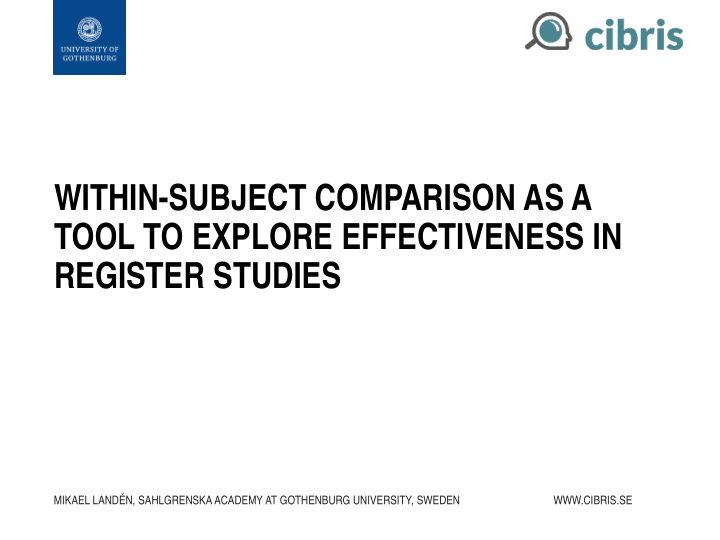



WITHIN-SUBJECT COMPARISON AS A TOOL TO EXPLORE EFFECTIVENESS IN REGISTER STUDIES MIKAEL LANDÉN, SAHLGRENSKA ACADEMY AT GOTHENBURG UNIVERSITY, SWEDEN WWW.CIBRIS.SE
Disclosures • Over the past 36 months: – lecture honoraria from Lundbeck pharmaceuticals and AstraZeneca Sweden – served as scientific consultant for EPID Research Oy. – No other equity ownership, profit-sharing agreements, royalties, or patent.
Bipolar disorder / Manic depressive illness • Recurrent episodes of extreme mood (mania and depression) Life chart of bipolar disorder ( Grande I et. al., 2016)
Three important clinical questions 1. Which mood stabilizing treatment is the most effective? 2. Do mood stabilizers decrease the risk for suicide attempts? 3. Can antidepressants or central stimulants be given to bipolar disorder patients without triggering manic episodes?
Observational studies • Draw inferences from a sample or population but do not control the independent variable – Case-control studies – Longitudinal studies • Pro – Provide information on ’real-world’ effectivness – Generalisable and can inform clinical practise
Observational studies - Contra Observational studies are hampered by indication bias – Treatment is not given randomly in the population – The outcome is associated with why the drug was given Severe illness Receiving treatment Worse outcome
There are ways to to do better observational studies • Sibling controls • Within-individual comparisons • … but no method is flawless
Identifying study subjects Pa rtic ipa nts Na tio na l Re g iste rs Outc o me s • >= 2 visits for a core National Patient Register bipolar diagnosis Psychiatric hospitalizations during 1973-2009 * • Mania Bipolar Quality Register * (Sellgren, et. al., 2011) • Depression • Born <1994 Mixed • Total Population Register • Reside in Sweden in 2005 Migration Register Suicide-related events N = ~35 000 Cause of Death Register • On medication with Prescribed Drug Register mood stabilizers E xpo sure 9/19/2017 10
Lichtenstein et al. Medication for Attention Deficit–Hyperactivity Disorder and Criminality. N Engl J Med 2012; 367:2006-2014, supplement
• Stratified Cox regression (stratified per individual) • No confounding from factors that are constant: e.g., genetic makeup, childhood events (but do not control for time varying covariates) Lichtenstein et al. Medication for Attention Deficit–Hyperactivity Disorder and Criminality. N Engl J Med 2012; 367:2006-2014, supplement
Erik Joas
Within-individual analysis Individual < 3 months < 3 months < 3 months A > 3 months > 3 months January December Time scale 2006 2009 Dispense Off medication On medication Events
SAHLGRENSKA AKADEMIN
SAHLGRENSKA AKADEMIN Miura, Tomofumi, et al. "Comparative efficacy and tolerability of pharmacological treatments in the maintenance treatment of bipolar disorder: a systematic review and network meta-analysis." The Lancet Psychiatry 1.5 (2014): 351-359.
SAHLGRENSKA AKADEMIN Miura, Tomofumi, et al. "Comparative efficacy and tolerability of pharmacological treatments in the maintenance treatment of bipolar disorder: a systematic review and network meta-analysis." The Lancet Psychiatry 1.5 (2014): 351-359.
SAHLGRENSKA AKADEMIN Miura, Tomofumi, et al. "Comparative efficacy and tolerability of pharmacological treatments in the maintenance treatment of bipolar disorder: a systematic review and network meta-analysis." The Lancet Psychiatry 1.5 (2014): 351-359.
SAHLGRENSKA AKADEMIN Miura, Tomofumi, et al. "Comparative efficacy and tolerability of pharmacological treatments in the maintenance treatment of bipolar disorder: a systematic review and network meta-analysis." The Lancet Psychiatry 1.5 (2014): 351-359.
SAHLGRENSKA AKADEMIN Miura, Tomofumi, et al. "Comparative efficacy and tolerability of pharmacological treatments in the maintenance treatment of bipolar disorder: a systematic review and network meta-analysis." The Lancet Psychiatry 1.5 (2014): 351-359.
SAHLGRENSKA AKADEMIN Miura, Tomofumi, et al. "Comparative efficacy and tolerability of pharmacological treatments in the maintenance treatment of bipolar disorder: a systematic review and network meta-analysis." The Lancet Psychiatry 1.5 (2014): 351-359.
Enriched design favours study drug Weisler, Richard H., et al. "Continuation of quetiapine versus switching to placebo or lithium for maintenance treatment of bipolar I disorder (Trial 144: a randomized controlled study)." The Journal of clinical psychiatry 72.11 (2011): 1-478.
Indication bias in between-individual analysis
Indication bias in between-individual analysis
Suicide-related events on lithium and valproate Rate of suicide-related event was reduced by 14% during on vs. off lithium medication periods Song et al, Am J Psych, 2017 Aug 1;174(8):795-802. Jie Song 28
Two questions: • Is there an increased risk for mania when a patient with bipolar disorder take an antidepressant or a central stimulant? • If so, can this be prevented by mood stabilizing treatment?
3,240 Monotherapy Antidepressant + mood stabilizer* 1,117 1,641 X Unambigous mood stabilizer treatment (not included) 482 *Lithium, Valproic acid, or Lamotrigine
Antidepressant monotherapy (N=1,117) Hazard ratio 95% CI P 0-3 months 2.83 (1.12-7.19) 0.028 3-9 months 0.71 (0.23-2.26) 0.567 Concurrent mood stabilizer treatment (N=1,641) Hazard ratio 95% CI P 0-3 months 0.79 (0.54-1.15) 0.214 3-9 months 0.63 (0.42-0.93) 0.020 Viktorin et al, Am J Psych, 2014
Antidepressant monotherapy (N=1,117) Hazard ratio 95% CI P 0-3 months 2.83 (1.12-7.19) 0.028 3-9 months 0.71 (0.23-2.26) 0.567 Concurrent mood stabilizer treatment (N=1,641) Hazard ratio 95% CI P 0-3 months 0.79 (0.54-1.15) 0.214 3-9 months 0.63 (0.42-0.93) 0.020 Viktorin et al, Am J Psych, 2014
Limitations and hurdles • Withdrawal / carry-over effects – Sensitivity analysis where time periods are added • Reversed causality – What if criminal behaviour triggers discontinuation of ADHD-medication? – Hypomania → antipsychotics → not sufficient → hospitalization – The method suits chronic better than acute treatment
Limitations and hurdles • Does the sequence of treatment matter? – 1st line treatment likely to be favoured since 2nd attempt is enriched with non responders – But this is a greater problem in RCTs where lithium responders (1st line) are unlikely to be included.
Conclusions • Observational register studies are important complements to randomized clinical trials but beware of indication bias. • Within-indivdual comparisons is a method that circumvents indication bias and controls for time-stationary confounders • But there is still a risk for reversed causality

Recommend
More recommend